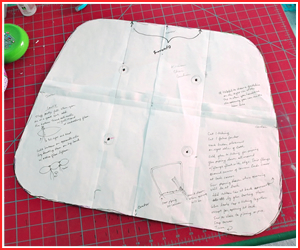A key to project success
Creating a proper template is the first and often most important step of your project. A properly made template will ensure the foam and upholstery are also made to the exact dimensions desired. Below you will find several tips to help in this important step.
Materials
It’s important to always use sturdy materials when creating a template. We recommend heavy-duty paper such as cardstock or construction paper, or even stronger materials like cardboard,

plastic or wood for making templates rather than newspaper or other soft papers. Templates made of lightweight materials can easily crumple or distort during the transport or transposing steps, making it difficult to achieve an identical match to the final product.
Template symmetry
The majority of cushions are designed to be symmetrical. If this is the case with your cushion, be sure to fold your template in half and compare the left and right edges. If they line up perfectly, your template should be ready to go. If they do not, determine which of the two edges is the correct shape of your cushion and adjust accordingly to ensure your new cushion is symmetrical.
“Dryfit” templating
When you’re not able to supply a template, or the one supplied is unusable, you may need to prepare a “dryfit” before proceeding to the custom upholstery portion of your project. This is often the case in boat reupholstery when the cushions supplied as templates are deformed from their original shape due to age or environmental conditions. In this case, the new foam will be cut to best-measure from the existing templates, then taken to the boat for an initial fitting. If the fitting requires adjustments, they’ll be made prior to the upholstery phase.
Help is close by
If you find yourself stuck in the template stage, stop by and get direction and advice from our helpful staff at a convenient location near you.
